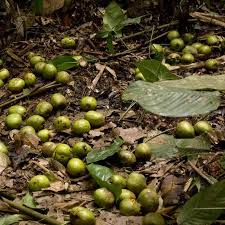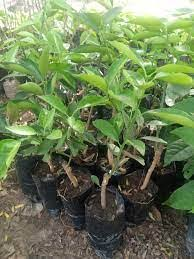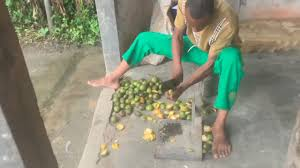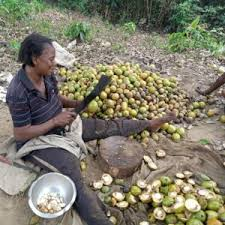Many tree species in the tropics hold significant potential but remain largely unknown to the international market and scientific community, leading to their underutilization.
In Nigeria, several trees fall into this category, including Irvingia (Akpon, Ogbono), Blighia sapida (Akee-apple or Isin), Chrysophyllum albidum (white star-apple), Gmelina arborea, Dacryodes edulis (African pear), Butyrospermum parkii (shea butter tree), and Tetrapleura tetraptera (Aidan tree), among others.
This article will provide a brief overview of current knowledge on the cultivation of Ogbono (Irvingia spp).iefly what is known so far on cultivation of Ogbono (Irvingea spp).
Ogbono Seed Extraction
Ripened fruits, preferably those that have fallen naturally, should be selected. Fruits plucked from the tree should not be used. The pulp should then be carefully and completely removed, and the nuts thoroughly washed using sand and water.
The nuts should be allowed to dry in the shade for one to two days during the dry season or three to four days during the wet season.
Prolonged drying of the seeds for more than seven days should be avoided, as it significantly reduces seed viability. It is important to emphasize that drying should be done in an airy, open space and not directly under the sun.
Ogbono Seed Germination

Seed germination should be carried out in a thick, durable, and intact polythene bag, basket, or perforated tray. The container should be filled with rich topsoil to a depth of approximately 17 cm, followed by a layer of uncontaminated sawdust to fill the next 10 cm.
The seed should then be planted in the center of the polythene bag, ensuring it is well-covered by the sawdust (refer to Figure 1 above).
Seeds should be planted within two to three days after extraction. If damping-off disease has been a recurring issue in the environment, the seeds should be treated with benlate by dusting them completely or using any other suitable recommended fungicide.
After planting, the seeds should be watered daily and kept in a shady environment. For a polythene bag with a diameter of about 15 cm, 3–4 seeds may be planted.
Germination typically begins around three weeks after planting and may continue for several weeks thereafter. After approximately 12 months, the seedlings will be ready for transplanting to the field or for budding.
Read Also: The Most Lucrative between Production of Fish Fingerlings or Raising them to Table Size
Budding of Ogbono

For budding, budwood should be obtained from mature flowering trees, ideally during the month of June in the rainy season. Rootstocks of about 0.5 cm in diameter (pencil size) and approximately 15 cm above the soil surface are required.
Budding should be carried out while the seedlings are still in the polythene bags in the nursery. The budded seedlings should be transplanted to the field 9–12 months after budding.
Field Establishment
The seedlings will be ready for transplanting to the permanent field site approximately 9 to 12 months after germination or 9 to 12 months after budding.
The seedlings should be transplanted into pre-dug holes measuring 1m x 1m x 1m, prepared at least two weeks in advance. The holes should be filled first with topsoil, followed by manure and 15:15:15 compound fertilizer, thoroughly mixed.
The recommended field spacing is 7m x 7m. Transplanting should be carried out in the month of June during the rainy season, ensuring the ball of earth around the roots remains intact during the process.
Field Management/Maintenance
A cover crop should be established to protect the soil, but it will need to be phased out as the trees develop their canopies. If desired, intercropping between rows with other crops, such as cassava, can be done during the first few years.
Seedlings should be watered or irrigated during the first dry season after transplanting into the field, as they may not have developed a sufficiently deep root system by then.
The first flowers formed by the seedlings in the initial years should be removed to encourage strong vegetative growth, supported by the application of manure.
Nitrogenous and potassium fertilizers should also be used. Regular weeding is essential to maximize yield from the inter-crop initially and from the trees later on.
Read Also: The Ultimate Step-by-Step Guide to Vegetable Gardening
Harvesting of Ogbono

Irvingia fruits should be harvested when they are mature. The timing of harvesting depends on the intended use of the fruits. If the fruits are being transported to distant markets from the production source, they should be harvested when mature but still green.
For fresh markets, the fruits should be allowed to fully ripen and fall from the tree, after which they can be collected once or twice daily. If the fruits are intended for use as seeds for germination, only those that are fully ripe and have fallen naturally from the tree should be used.
Regardless of the purpose, damaged or bruised fruits should be avoided during harvesting to prevent the spread of diseases.
Uses of Ogbono
Irvingia fruits are considered delicacies due to their limited availability. They are consumed as fresh fruits, particularly in the southwestern and eastern zones of Nigeria. In Ibadan land, they are highly valued as fruits and desserts.
The popularity of fresh Irvingia fruits is gradually spreading to the northern zones of Nigeria, largely due to southerners residing in the north who ship the fruits from the south.
Efforts are being made to encourage delayed ripening, and researchers are continuing their work to ensure the availability of Irvingia fruits throughout the year. The most widespread use of Irvingia across the country is as a key ingredient in the preparation of draw soup, commonly known as Ogbono soup.
It is used either alone or in combination with “egusi” and/or other vegetables, and it is typically served with pounded yam, eba, fufu, amala, or semovita. Additionally, Irvingia holds potential as a future juice drink.
Chemical Composition
Irvingia is a promising fruit tree for the future. Limited research has been conducted by food nutritionists on its chemical nutrition. However, its chemical composition is believed to be similar to that of mango.
The fruit is rich in vitamin C and contains comparable levels of protein. The seed is a good source of protein, carbohydrates, and contains trace amounts of vitamins. Irvingia is also said to have medicinal value.
Pests and Diseases of Ogbono
There are not many known pests and diseases of Irvingia. The tree is generally free from pest attacks and disease infections. However, in some areas, fungal diseases such as damping off may occur. This can be effectively controlled by dusting seeds with benomyl or any other suitable fungicide before planting.
Do you have any questions, suggestions, or contributions? If so, please feel free to use the comment box below to share your thoughts. We also encourage you to kindly share this information with others who might benefit from it. Since we can’t reach everyone at once, we truly appreciate your help in spreading the word. Thank you so much for your support and for sharing!
Read Also: What You Need to Know About Osteospermum
Frequently Asked Questions
We will update this section soon.

